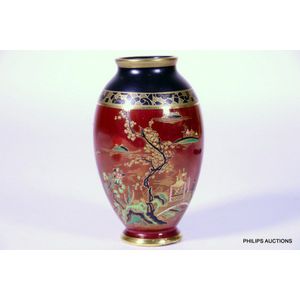1927 Carlton Ware Temple Vase with Oriental Motifs
You must be a subscriber, and be logged in to view price and dealer details.
Subscribe Now to view actual auction price for this item
When you subscribe, you have the option of setting the currency in which to display prices to $Au, $US, $NZ or Stg.
- Circa - A Latin term meaning 'about', often used in the antique trade to give an approximate date for the piece, usually considered to be five years on either side of the circa year. Thus, circa 1900 means the piece was made about 1900, probably between 1895 and 1905. The expression is sometimes abbreviated to c.1900.
- Kakiemon Porcelain - Kakiemon porcelain was made from the 16th to the 19th century in the Arita area of Japan, and is generally agreed to include some of the finest porcelain made in Japan. It is decorated with polychrome enamels over glaze, the most popular colours being underglaze blue and enamels of green, blue, turquoise yellow and persimmon red.
The body of a Kakiemon object is pure white porcelain while the enamel overglaze motifs incorporate Japanese and Chinese designs, but leave much of the white surface unpainted. The name derives from the family of potters who are associated with this style of pottery.
Early Kakiemon porcelain was unmarked, and marks on later objects were variable and unreliable.
Kakiemon porcelain was first imported into Europe by the Dutch at the end of the 17th century, and became extremely popular, resulting in Kakiemon-style imitations being produced by European potteries including Bow, Chelsea and Worcester in England, Mennery, Samson and St. Cloud in France, Delft in Holland and Meissen in Germany.
It's rare for an original Kakiemon object to come onto the market, and almost all sold nowadays is of European origin, and described as Kakiemon pattern or Kakiemon style. - Attributed - A cataloguing term where the item in the opinion of the cataloguers, is a of the period of the artist, craftsman or designer, and which probably in whole or part is the work of that person.
This item has been included into following indexes:
-
Carlton Ware (England), item types
- figurines 42
- vases and ewers 286
- Carlton Ware (England), patterns
- Wain, Horace, England - Carlton Ware (England), designers 3
Visually similar items

A small Royal Crown Derby vase, late 19th century, the small waisted baluster vase with a spreading foot in cherry red and embellished throughout with a gold paste floral and foliate design; black backstamp without script or date cypher. Height 9 cm.

Pair of Satsuma vases. Meiji Period (1868-1911), each of baluster form painted with peacock in foliage in landscape. 25 cm high

Florence E Barlow, Doulton Lambeth pair of vases having a highly glossed glaze with a central band painted with a bird. Stamped & signed to the bases. Condition: good, minor age related wear to the bases. Height 41 cm

A large Walter Moorcroft 'Anemone' pattern baluster vase, Impressed marks. Height 25.5 cm
